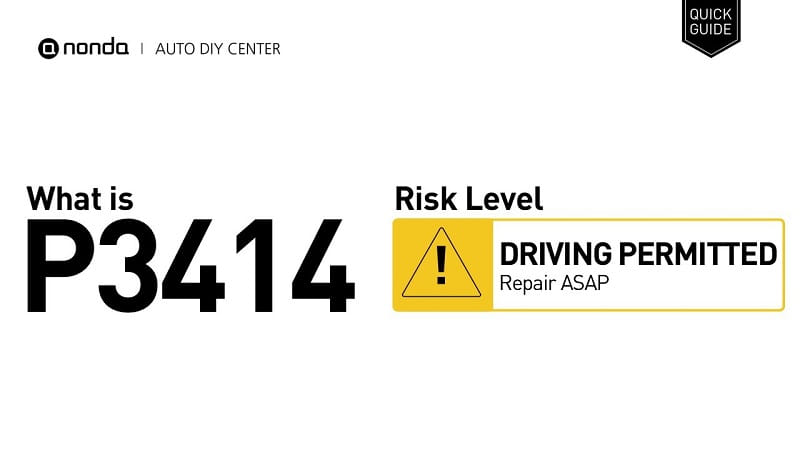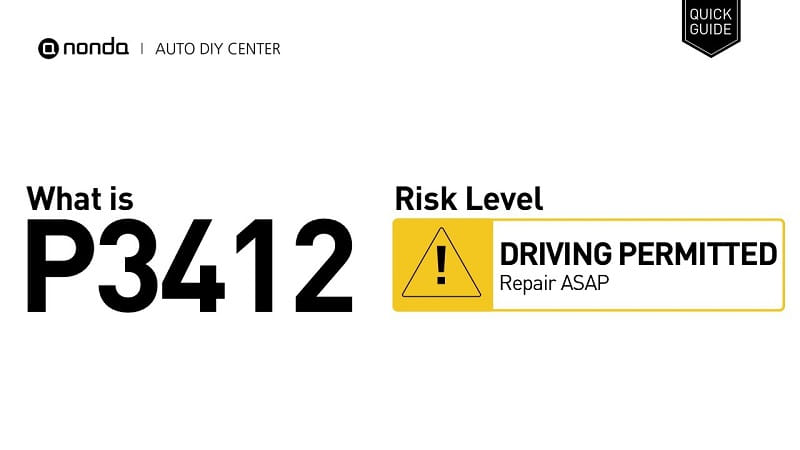This post contains affiliate links. This means I will make a commission at no extra cost to you should you click through and make a purchase [ “As an Amazon Associate, I earn from qualifying purchases.” ]. Read the full disclosure here.
Understanding Diagnostic Trouble Code P3412 Cylinder 2 Deactivation/Intake Valve Control Circuit High GuideMechanic.Com The complexity of modern engines has increased significantly due to the integration of advanced systems designed to improve fuel efficiency, reduce emissions, and enhance performance.
One such system is cylinder deactivation, which allows an engine to operate on fewer cylinders during light-load conditions.
When faults occur within this system, the engine control module (ECM) detects them and stores diagnostic trouble codes (DTCs) to help technicians pinpoint the problem. One such code is P3412 – Cylinder 2 Deactivation/Intake Valve Control Circuit High.
This article provides a comprehensive look into what the P3412 code means, its causes, symptoms, diagnosis procedures, and solutions.
See Also: P3413 Cylinder 2 Exhaust Valve Control Circuit/Open
P3412 Cylinder 2 Deactivation/Intake Valve Control Circuit High
What Is Code P3412?

The diagnostic trouble code P3412 is triggered when the ECM detects abnormally high voltage in the intake valve control circuit for cylinder 2.
This circuit is part of the cylinder deactivation system, which uses electrical solenoids and oil pressure to deactivate specific cylinders when the engine is under light load or cruising conditions.
Cylinder deactivation systems are commonly found in engines from manufacturers like General Motors (GM), Honda, Chrysler, and others.
These systems work by disabling the intake and exhaust valves in certain cylinders and cutting fuel injection to reduce engine displacement, thereby saving fuel. The intake valve control solenoid for each cylinder plays a crucial role in this operation.
When the ECM commands the solenoid for cylinder 2 to operate, it expects a specific voltage range. If the voltage reading is higher than the expected threshold, the ECM stores code P3412, indicating a high circuit condition, which may point to an open circuit or an internal fault in the solenoid.
P3412 Cylinder 2 Deactivation/Intake Valve Control Circuit High
Symptoms of P3412
The symptoms of code P3412 can vary depending on the severity of the fault and the make and model of the vehicle. However, common symptoms include:
- Illuminated Check Engine Light (CEL): The most immediate sign of a stored trouble code.
- Engine Runs Rough: Rough idling or inconsistent acceleration due to improper cylinder deactivation.
- Reduced Engine Performance: The engine may enter a failsafe or limp mode to prevent damage.
- Increased Fuel Consumption: The cylinder deactivation system is disabled, causing all cylinders to run continuously.
- Unusual Engine Noises: Ticking or tapping noises may result from malfunctioning valve solenoids.
- Possible Engine Misfire: Although rare, a faulty valve control system can sometimes cause misfires.
P3412 Cylinder 2 Deactivation/Intake Valve Control Circuit High
Common Causes of P3412
Several potential issues can cause a high voltage condition in the intake valve control circuit for cylinder 2. These include:
- Faulty Intake Valve Control Solenoid (Cylinder 2): An internal electrical failure can lead to high resistance or an open circuit.
- Open Circuit in Wiring Harness: Broken wires or poor connections can result in high voltage readings.
- Corroded or Loose Electrical Connectors: This can interrupt proper current flow, causing voltage spikes.
- Short to Power in the Circuit: An unintended connection to a power source may cause abnormally high voltage.
- Faulty ECM/PCM: In rare cases, the engine control module itself may be the source of the issue.
- Low Engine Oil Pressure or Dirty Oil: Indirectly, this can affect the valve control system’s operation, although it’s more likely to cause other codes.
P3412 Cylinder 2 Deactivation/Intake Valve Control Circuit High
How to Diagnose Code P3412
Correctly diagnosing the cause of the P3412 code is essential to avoid misdiagnosis and unnecessary part replacement. Below is a step-by-step guide for diagnosis:
1. Use an OBD-II Scanner
Scan the vehicle to verify the presence of P3412 and check for any related DTCs, such as P3400 (general cylinder deactivation code) or misfire codes like P0302.
2. Perform a Visual Inspection
Check the wiring harness and connectors leading to the cylinder 2 intake valve control solenoid.
Look for damaged insulation, chafing, corrosion, or loose terminals.
3. Test the Solenoid
Using a digital multimeter, test the solenoid’s resistance and compare it with manufacturer specifications.
An infinite resistance reading may indicate an open circuit, confirming a “high” condition.
4. Check for Voltage at the Connector
With the ignition on, use a test light or multimeter to verify voltage at the solenoid connector.
An abnormally high voltage reading may indicate a short to power.
5. Check ECM Outputs
If the solenoid and wiring are intact, the ECM’s output control should be tested.
This usually requires specialized tools or software and may be best left to a professional.
6. Oil Inspection
Check the oil level and quality. Although not a direct cause, poor lubrication can contribute to valve train irregularities.
P3412 Cylinder 2 Deactivation/Intake Valve Control Circuit High
How to Fix Code P3412
After identifying the root cause of the P3412 code, the next step is performing the appropriate repair. Potential fixes include:
1. Replace the Intake Valve Control Solenoid for Cylinder 2
If the solenoid has high resistance or is open, replace it with an OEM or high-quality aftermarket part.
2. Repair or Replace Damaged Wiring
If wiring faults are found, repair or replace the affected wires and ensure they are properly insulated and routed.
3. Clean or Replace Corroded Connectors
Clean connectors using electrical contact cleaner or replace them if corrosion is extensive.
4. Fix a Short to Power
Locate and eliminate any points in the circuit where voltage is leaking into the control wire.
5. ECM Repair or Replacement
If all components are working correctly but the code persists, the ECM may need to be tested and reprogrammed or replaced.
6. Perform Oil Change
If the oil is dirty or low, replace it with the correct grade and quantity specified by the manufacturer.
P3412 Cylinder 2 Deactivation/Intake Valve Control Circuit High
Preventive Measures
To reduce the likelihood of encountering code P3412 in the future, consider these preventive steps:
- Regular Oil Changes: Use manufacturer-recommended oil types and change them at scheduled intervals.
- Inspect Wiring Routinely: Periodically check wiring harnesses and connectors for early signs of wear.
- Use Quality Parts: Only use reliable, OEM-approved parts for repairs and maintenance.
- Avoid Engine Overloads: Do not push the engine excessively under high-load conditions if it’s not designed for it.
- Stay Updated on TSBs and Recalls: Manufacturers may release service bulletins that provide fixes for known issues.
Conclusion
The P3412 – Cylinder 2 Deactivation/Intake Valve Control Circuit High code points to an electrical issue in the system responsible for cylinder deactivation in modern engines.
This condition often stems from a faulty solenoid, open wiring, or electrical shorts and must be addressed promptly to restore optimal engine performance and fuel efficiency.
Understanding the causes and symptoms of this code empowers vehicle owners and technicians to take accurate and efficient steps toward diagnosis and repair.
With regular maintenance, proper troubleshooting procedures, and timely repairs, the cylinder deactivation system can function reliably and continue to offer the benefits of fuel economy and reduced emissions that it was designed to deliver.
- Custom Lifted Diesel Trucks for Sale - December 20, 2025
- New Lifted Diesel Trucks for Sale - December 19, 2025
- Old Lifted Diesel Trucks for Sale - December 18, 2025

